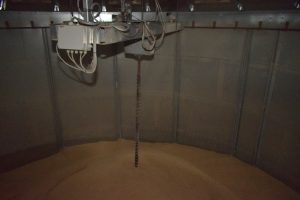In an outdoor silo with a stirring installaton it is possible to dry wet grain back to 15% in a controlled manner and store it for a long time. The stirring system in a grain silo consists of one or more vertical augers on a stirring arm. This arm hangs at the top of the silo and runs over a rail, which is mounted on the wall.
If the grain enters wet, it is desirable to dry the product as soon as possible to avoid loss of quality. Moreover, the drying capacity of the outdoor air in August and September is better than in October. The outside temperature is also still at a reasonable level. Good drying air has a relative humidity1 of 65% and a temperature comparable to that of the grain.
In practice it is often possible to dry the wheat in an outdoor silo without the use of heaters. The stirring installation in the silo significantly increases the air permeability of the product. The installation also sets the product in motion, which accelerates the drying process.
If the grain is very wet or the weather conditions are unfavorable, a heater can be placed in front of the fan to create extra drying power. The heating of the drying air should not be too high; approx. 5-8 degrees. If the heating is higher, the relative humidity of the drying air becomes too low and there is a greater risk of condensation in the product.
Drying key points in an outdoor silo:
- Dry the product as soon as possible after harvesting.
- Dry with the correct air (relative humidity and temperature) without cooling too much.
- Use a heater in bad conditions and warm the air about 5-8 degrees.
- Regularly check the product temperature and moisture content.

Key points to storing/cooling in an outdoor silo
After the drying process start cooling as soon as possible (by cooling grain dries a few tenth of a percent).
Ventilate the solar heat quickly when the grain has been harvested dry. Cool with air that is atleast 4 to 5 degrees colder than the product. Aerate the grain often, especially in the beginning, to get to the right temperature. Take into account the average temperature in different periods; cool the grain according to the temperature of the season. This prevents condensation of the roop of the silo Check the temperature and temperature trend regularly.
We recommend the following grain temperatures in the months of August – April:
August 19 ° C
September 18 ° C
October 14 ° C
November 10 ° C
December 7 ° C
January 6 ° C
February 6 ° C
March 9 ° C
April 13 ° C
1Relative Humidity: A ratio (in%), which indicates how much water vapor air contains relative to the maximum amount of water vapor the air can contain. A value of 100% indicates the maximum amount of water vapor: the air is then saturated. The warmer the air, the more water vapor it can hold.







